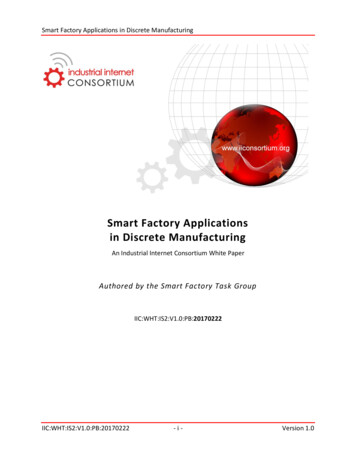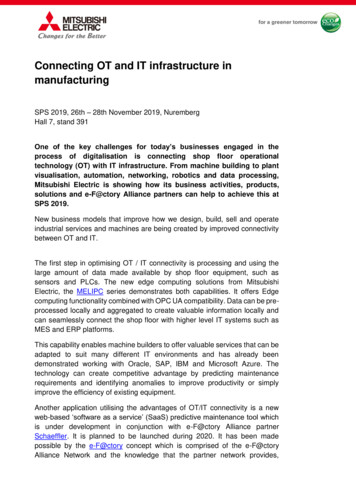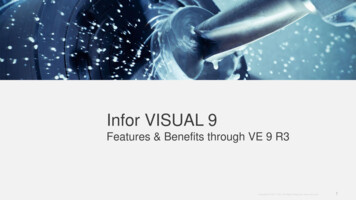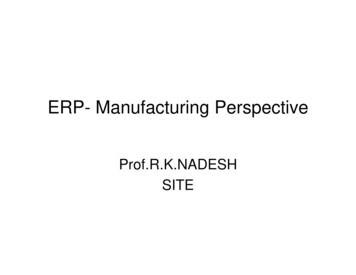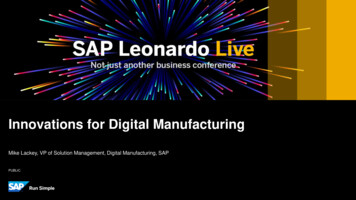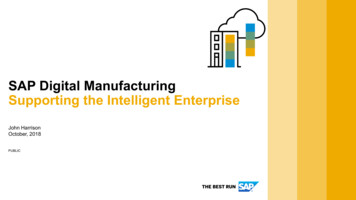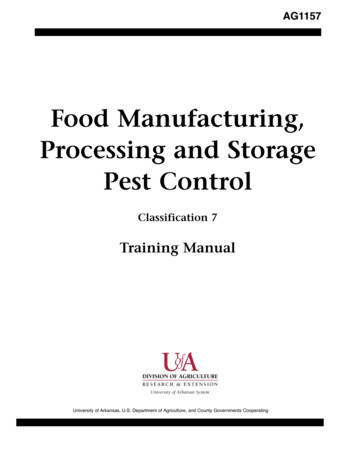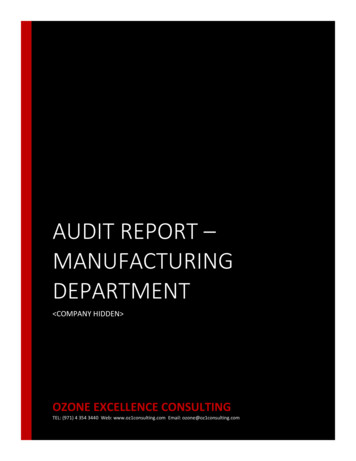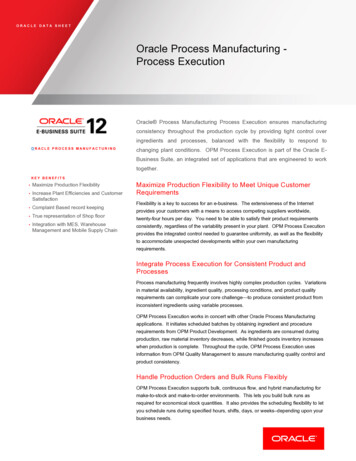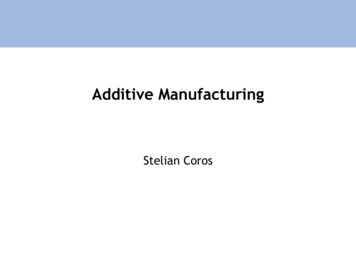
Transcription
Additive ManufacturingStelian Coros
Reminder - Mini assignment! Design a unique, functional object that youwould like to have– Pencil holder, chair, toy, lamp, etc – Just a concept drawing or description Remember– Endless design opportunities– Think outside the box
Basics of 3D Printing“3D Printing” coinedat MIT in 1995
Additive vs. Subtractive ManufacturingMuch of current manufacturing is subtractive
Subtractive Manufacturing
Subtractive Manufacturing – Limitations?
Basics of 3D Printing – possible issues? Overhangs & support structures Print direction Fill-in and hollow objects Materials Layer Resolution Price Safety and ease of operation Need for post-processing
Overview of 3D Printing Technologies Fused deposition modeling (FDM) Stereolithography (SLA) DLP 3D printing Photopolymer Phase Change Inkjets (PolyJet) Selective laser sintering (SLS)–Direct metal laser sintering (DMLS) Plaster-based 3D printing (PP)– Powder bed and inkjet head 3D printing Thermal Phase Change Inkjets Laminated object manufacturing (LOM)
Overview of 3D Printing Technologies Fused deposition modeling (FDM) Stereolithography (SLA) DLP 3D printing Photopolymer Phase Change Inkjets (PolyJet) Selective laser sintering (SLS)–Direct metal laser sintering (DMLS) Plaster-based 3D printing (PP)– Powder bed and inkjet head 3D printing Thermal Phase Change Inkjets Laminated object manufacturing (LOM)
Fused Deposition Modeling (FDM)Developed by Scott and Lisa Crump in the late 80sFDM is trademarked by StratasysAKA Fused Filament Fabrication (FFF)
Fused Deposition Modeling (FDM)source: http://reprap.org
Fused Deposition Modeling (FDM) Filament is made ofthermoplastic materials– Acrylonitrile butadienestyrene (ABS)– Polylactide (PLA) –biodegradable!– Many new materialssource: makerbot.com
Fused Deposition Modeling (FDM) Dual extruder machines exist– Temporary support structures can be made from water-soluble material– Two colorsSupport MaterialModeling Material
FDM Process Timelapse https://www.youtube.com/watch?v ik39 sv-wgQ
Fused Deposition Modeling – Commercial Systems Stratasys– Dimension family Z resolution: 0.18 mm Build size: 8 x 8 x 12 inches Limited color Limited material types
Fused Deposition Modeling – Clones MakerBot Delta 3D Printer Ultimaker Cube from 3D Systems And many others
Overview of 3D Printing Technologies Fused deposition modeling (FDM) Stereolithography (SLA) DLP 3D printing Photopolymer Phase Change Inkjets (PolyJet) Selective laser sintering (SLS)–Direct metal laser sintering (DMLS) Plaster-based 3D printing (PP)– Powder bed and inkjet head 3D printing Thermal Phase Change Inkjets Laminated object manufacturing (LOM)
Stereolithography (SLA) SLA uses liquid photoreactive resin Laser beam traces onelayer on the surface ofthe resin Laser light cures andsolidifies parts it hits The platform descends byone layer
Stereolithography (SLA) Support structure– thin support lattice can be broken off
Stereolithography Processhttp://www.youtube.com/watch?feature player embedded&v 5L5vdpklrtU
Stereolithography - History Developed by Charles Hull in the 80s– Coined term stereolithography– Founded 3D Systems in 1986Charles Hull next to one of his latest3D printers, the SLA7000
Stereolithography – 3D Systems Two main families– ProJet– iPro Build volume: varies, can be very large Resolution up to 0.05mm Materials (only one can be used):– photopolymers– clear, opaque, temperature resistant,ceramic-like, abs-like
Stereolithography – Clones Formlabs– Smaller build volume– Similar resolution– Much less expensive
Overview of 3D Printing Technologies Fused deposition modeling (FDM) Stereolithography (SLA) DLP 3D printing Photopolymer Phase Change Inkjets (PolyJet) Selective laser sintering (SLS)–Direct metal laser sintering (DMLS) Plaster-based 3D printing (PP)– Powder bed and inkjet head 3D printing Thermal Phase Change Inkjets Laminated object manufacturing (LOM)
Digital Light Projector (DLP) 3D Printing DLP 3D also uses liquidultraviolet curablephotopolymer resin DLP exposes and solidifiesone layer at a time onthe surface of the resin The Z-axis moves by onelayer
DLP 3D Printing Features Similar to SLA– laser mirror is replaced by a projector Simple design– only one degree of freedom Faster than SLA– exposes one layer at a time Materials– same as SLA No additional support material– Lattice structure similar to SLA
DLP 3D Printing – Commercial Systems Perfactory from eZ resolution 50 micronsXY resolution 50 micronsprojector resolution (2800x2100 pixels)Build volume 5.5 x 4.1 x 9.1 inches
DLP 3D Printing - ters.html
DLP 3D Printing – DIY Video
Overview of 3D Printing Technologies Fused deposition modeling (FDM) Stereolithography (SLA) DLP 3D printing Photopolymer Phase Change Inkjets (PolyJet) Selective laser sintering (SLS)–Direct metal laser sintering (DMLS) Plaster-based 3D printing (PP)– Powder bed and inkjet head 3D printing Thermal Phase Change Inkjets Laminated object manufacturing (LOM)
Photopolymer Phase Change Inkjets Inkjet printhead jetsliquid photopolymer andsupport material UV light curesphotopolymer andsupport material Excess material isremoved using a roller The platform descends byone layerSource: gy.asp
Printing Processhttps://www.youtube.com/watch?v XLLq9SwSTpM
Photopolymer Phase Change Inkjets Features Similar to SLA– Also uses photopolymers The only technology supporting multiple materials– Currently two support material Materials– Photopolymers only– Can be mixed before curing - graded materials– Soft, rigid, opaque, transparent, different colors
Photopolymer Phase Change Inkjets - CommercialSystems Objet (now Stratasys)––––––Called PolyJetEden series (one material support)Connex series (two materials support)Build size: 19.3 x 15.4 x 7.9 inchesZ resolution: up to 16 microns (1600 dpi)XY resolution 600 dpi
Sample Fabricated ObjectsSource: Objet Geometries
Rubber-like Materials
Multiple Materials
Overview of 3D Printing Technologies Fused deposition modeling (FDM) Stereolithography (SLA) DLP 3D printing Photopolymer Phase Change Inkjets (PolyJet) Selective laser sintering (SLS)–Direct metal laser sintering (DMLS) Plaster-based 3D printing (PP)– Powder bed and inkjet head 3D printing Thermal Phase Change Inkjets Laminated object manufacturing (LOM)
Selective Laser Sintering (SLS)Direct Metal Laser Sintering (DMLS) SLS and DMLS use a bedof small particles (madeof plastic, metal,ceramic, or glass) High-power laser tracesone layer on the surfaceof the powder bed fusingthe particles The platform descends byone layer and morematerial is addedSource: http://en.wikipedia.org/wiki/Selective laser sintering
Selective Laser Sintering (SLS)Direct Metal Laser Sintering (DMLS) SLS and DMLS use a bedof small particles (madeof plastic, metal,ceramic, or glass) High-power laser tracesone layer on the surfaceof the powder bedmelting/fusing theparticles The platform descends byone layer and morematerial is addedSource: http://en.wikipedia.org/wiki/Selective laser sintering
SLS & DMLS Features Laser and scanner system– Similar do SLA but laser is more powerful Bulk material can be preheated– Reduces the required energy to melt it Materials– One material at a time– Glass, polymers (e.g., nylon, polysterine), metals (e.g., steel,titanium, alloys), ceramic Does not require support structure– Overhangs are supported by powder material
Single- and Two-Component PowdersSource: Tolochko et al. 2003
Raw Powder ParticlesRaw Ni-alloy-Cu powder mixtureRaw Fe-Cu powder mixtureSource: Tolochko et al. 2003
Sintered PowdersSingle component Fe powder after sinteringSource: Tolochko et al. 2003
Sintered PowdersFe-Cu powder mixture after sinteringSource: Tolochko et al. 2003
SLS & DMLS Processhttps://www.youtube.com/watch?v BZLGLzyMKn4
SLS & DMLS - History Invented at UT Austin by Joe Beaman and Carl Deckard (80s)This is part of the original machine, nicknamed Betsy,made by Carl Deckard as a graduate student in 1986.One of the first attempts at making an object withselective laser 2/0612 selective laser sintering.php
Commercial Systems 3D Systems– sPro family & Pro DM EOS GmbH– Formiga and EOSINT family Requires powerful laser– 30W for SLS– 400W for DMLS Layer thickness: 0.02 – 0.08mm
Sample Fabricated PartsSources: http://www.bridgesmathart.org , http://www.freedomofcreation.com
Sample Fabricated Parts3D printed, titanium central wing sparAirbus wing bracketsSource: ponoko.com, 3dprintingindustry.com
Overview of 3D Printing Technologies Fused deposition modeling (FDM) Stereolithography (SLA) DLP 3D printing Photopolymer Phase Change Inkjets (PolyJet) Selective laser sintering (SLS)–Direct metal laser sintering (DMLS) Plaster-based 3D printing (PP)– Powder bed and inkjet head 3D printing Thermal Phase Change Inkjets Laminated object manufacturing (LOM)
Plaster-based 3D Printing This method uses a bed ofsmall plaster particles Inkjet printhead printswith liquid adhesive(possibly colored), onelayer on the surface ofthe powder bed fusingthe particles The platform descends byone layer and morematerial is addedSource: Zhou and Lu, 2011
Plaster-based 3D Printing Features Similar to SLS and DMLS– Also uses granular materials– Uses inkjet printhead instead of laser– Glues particles instead of melting them Does not require support structure– Overhangs are supported by powder material The only technology supporting full-color printing Materials– Plaster only– Color can be applied (typically on/near the surface) Brittle, requires post-processing
Plaster-based 3D Printing Processhttps://www.youtube.com/watch?v GnFxujCyD70
Plaster-based 3D Printing - History Developed at MIT– http://web.mit.edu/tdp/www/whatis3dp.html Commercialized by Z Corporation in 1995MIT Alpha Machine
Plaster-based 3D Printing – Commercial Systems Z Corporation (now 3D Systems)––––––Z-Printer familyUses HP inkjet print heads390K colorsXY resolution: 600 x 540dpiZ resolution: 0.1mmBuild size: 20 x 15 x 9 inchesZPrinter 250ZPrinter 850Source: Z corporation
Fabricated PartsSource: Z corporation
Overview of 3D Printing Technologies Fused deposition modeling (FDM) Stereolithography (SLA) DLP 3D printing Photopolymer Phase Change Inkjets (PolyJet) Selective laser sintering (SLS)–Direct metal laser sintering (DMLS) Plaster-based 3D printing (PP)– Powder bed and inkjet head 3D printing Thermal Phase Change Inkjets Laminated object manufacturing (LOM)
Thermal Phase Change Inkjets Inkjet printhead jetsheated liquid plastic andsupport material (wax) Material droplets solidifyas they cool down Excess material isremoved using a millinghead to make a uniformthickness layer Particles are vacuumedawaySource: http://www.additive3d.com/bpm.htm The platform descends byone layer
Thermal Phase Change Inkjets Features Extremely high resolution Slow printing time Materials– Limited: plastics and waxes Support material– Wax: easy to remove Manufactured objects are used as casting pattern butalmost never as final functional parts
Thermal Phase Change Inkjets – Commercial Systems Produced by Solidscape (now Stratasys)––––3Z ProXY resolution: 5000 x 5000 dpiY resolution: 8000 dpiBuild volume: 6 x 6 x 4 inchesSource: http://www.solid-scape.com
Sample Fabricated PartsSource: SolidscapeSource: http://www.protojewel.com
Overview of 3D Printing Technologies Fused deposition modeling (FDM) Stereolithography (SLA) DLP 3D printing Photopolymer Phase Change Inkjets (PolyJet) Selective laser sintering (SLS)–Direct metal laser sintering (DMLS) Plaster-based 3D printing (PP)– Powder bed and inkjet head 3D printing Thermal Phase Change Inkjets Laminated object manufacturing (LOM)
Laminated Object Manufacturing (LOM) Sheet is adhered to a substratewith a heated roller Laser traces desireddimensions of prototype Laser cross hatches non-partarea to facilitate wasteremoval Platform with completed layermoves down out of the way1 Foil supply. 2 Heated roller. 3 Laserbeam. 4. Scanning prism. 5 Laser unit. 6Layers. 7 Moving platform. 8 Waste. Fresh sheet of material isrolled into position Platform moves up intoposition to receive next layerSource: http://en.wikipedia.org/wiki/Laminated object manufacturing
Printing Processhttp://www.youtube.com/watch?v Z1WNA6tdfWM
Laminated Object Manufacturing Features Inexpensive – low material cost Print resolution is lower than other methods Color can be added using additional printhead Materials– Paper (most common), plastics, composites, metal,ceramics Support material– Same material can be used as support
Support MaterialSource: es/laminated-object-manufacturing-lom/
Commercial Systems Helisys (now Cubic Technologies)–––––SD300Build Size 160 x 210 x 135 mmZ resolution: 0.3 mmXY resolution 0.2 mmBuild material – plastics
Printing Processhttps://www.youtube.com/watch?v nE-8Wnz9-Qc
Sample Fabricated ObjectsSource: http://www.solido3d.com
Overview of 3D Printing Technologies Fused deposition modeling (FDM) Stereolithography (SLA) DLP 3D printing Photopolymer Phase Change Inkjets (PolyJet) Selective laser sintering (SLS)–Direct metal laser sintering (DMLS) Plaster-based 3D printing (PP)– Powder bed and inkjet head 3D printing Thermal Phase Change Inkjets Laminated object manufacturing (LOM)
Questions
That’s A
Sheet is adhered to a substrate with a heated roller Laser traces desired dimensions of prototype Laser cross hatches non-part area to facilitate waste removal Platform with completed layer moves down out of the way Fresh sheet of material is rolled into position Platform moves up into position to receive next layer 1 Foil supply. 2 Heated roller. 3 Laser beam. 4 .



